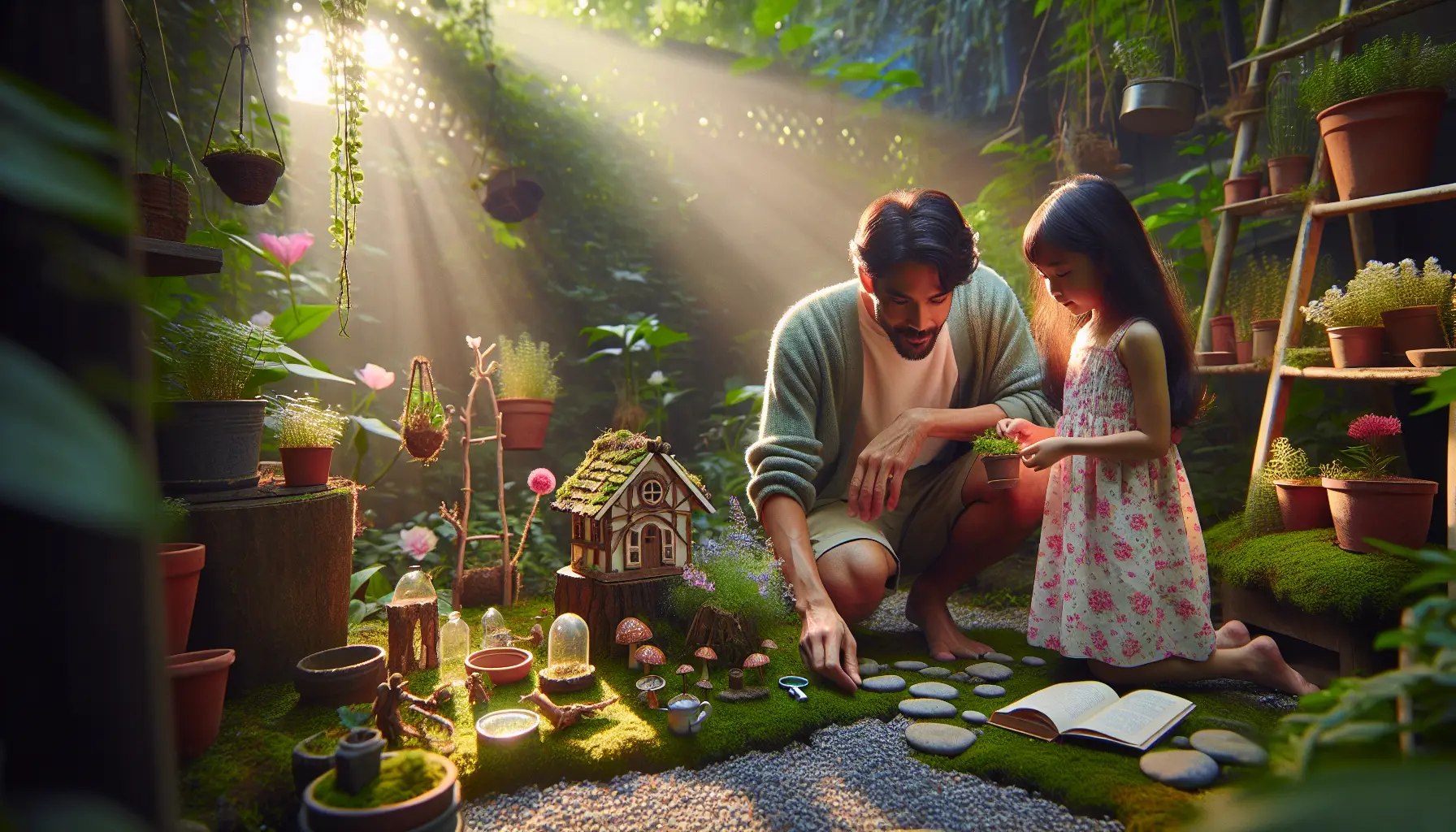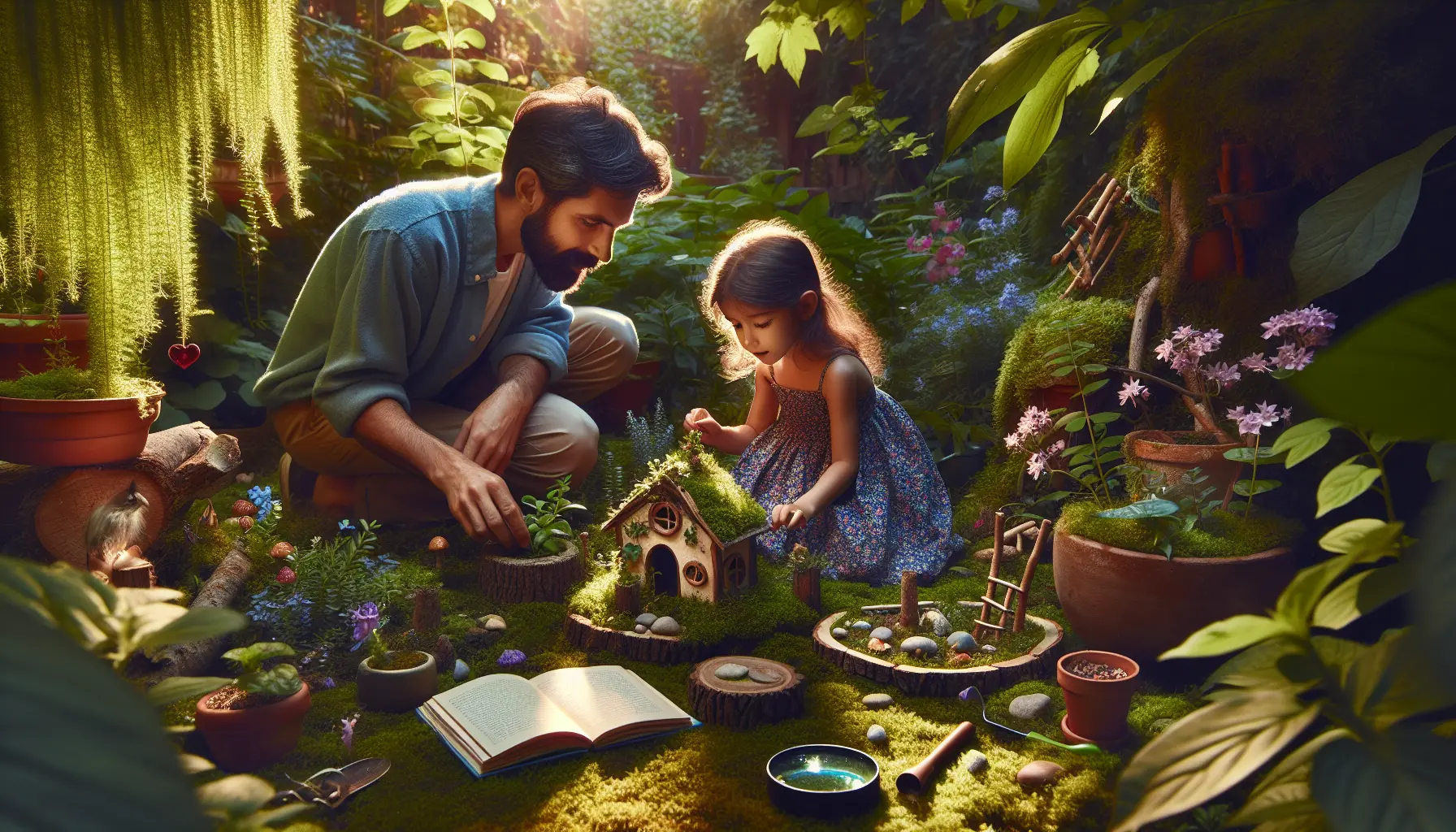Fairy Gardens with Kids Create Magical Mini Worlds

As children discover the joy of getting their hands dirty in a sunny spot, their eyes light up with a carefree sense of freedom. When we encourage this sense of wonder, we ignite a spark that can lead to a lifelong love of nature and the outdoors.
Fairy gardens with kids can be a magical way to spend time and create a mini world that sparks imagination and creativity in children, encouraging a lifelong love of nature and the outdoors.
By engaging in hands-on activities like planting, watering, and nurturing, kids can develop essential life skills, such as responsibility and empathy. This hands-on approach not only fosters a sense of accomplishment but also teaches kids the importance of caring for others – whether it’s a tiny fairy dancing on a toadstool under the radiant glow of a mystical moonbeam.
Fairy Gardening with Kids
Unlocking a world of wonder and creativity can be as simple as cultivating a tiny haven in your own backyard. By engaging children in garden design and maintenance, parents can foster a sense of responsibility, nurturing their confidence and nurturing a lifelong appreciation for nature.
This enchanting activity offers a unique opportunity for families to bond over a shared project, creating lasting memories and instilling a sense of pride in their accomplishments.
As children tend to the tiniest of plants, they develop essential skills in problem-solving, critical thinking, and fine motor control, all while enjoying the therapeutic benefits of connecting with the great outdoors. By creating a miniature world where fairies and other whimsical creatures come to life, parents can inspire their children’s imagination, encouraging them to explore, and develop a deeper appreciation for the natural world through interactive, educational, and creative gardening activities.

Whimsical Miniature Worlds
Unlocking the Boundless Potential of Small Wonders In a world where technology reigns supreme, the art of nurturing creativity in miniature serves as a refreshing antidote, allowing individuals to reconnect with their inner child and unlock the boundless potential of small wonders.
The resurgence of miniature worlds as a popular hobby is a testament to the power of play in fostering imagination and creativity, as people of all ages rediscover the joy of exploring and shaping tiny ecosystems.
Whimsical miniature worlds have been around for centuries, with origins tracing back to Ancient Greece and Rome.
Today, these tiny ecosystems have evolved to become an integral part of contemporary art, design, and even therapy, offering a unique platform for expression and discovery. the rise of play-based activities and the increasing interest in botanical and horticulture pursuits, driven by the desire for hands-on exploration, discovery, and imagination in a miniature, plant-based setting with lush foliage and vibrant flora, fostering a deeper connection with nature.
How to Create a Joyful Space
Happiness is contagious, and it can start with the smallest changes in our surroundings.
Research indicates that our surroundings play a significant role in shaping our mental well-being, with joyful spaces having a profound impact on both adults and children.
By creating an environment that sparkles with positivity, we can boost our mood, reduce stress, and increase our overall sense of happiness.
Unlocking the Power of Joyful Spaces
The terrain of our minds is often reflected in the terrain of our homes, and by cultivating a joyful space, we can transform our inner landscape.
Understanding the Power of Joyful Spaces
The science behind joyful spaces is rooted in the concept of biophilia, which suggests that humans have an innate affinity for nature and natural environments. By incorporating elements that mimic the textures and patterns of the surrounding fauna, soil, terrain, and atmosphere, the terrarium becomes a miniature recreation of the natural world, complete with succulents, cacti, moss, lichen, and even gemstones embedded within its container.
Magical Planting Tips
A Journey of Discovery and Wonder Introducing gardening to children can be a transformative experience, fostering a sense of interconnectedness with nature and promoting a deeper appreciation for the beauty of the natural world. As they tend to the soil, shape the earth, and nurture young shoots, they’re not just developing important life skills – they’re also cultivating a sense of creativity, curiosity, and wonder.
The Magic of Microclimates
Microclimates are tiny, self-sustaining ecosystems within a miniature garden.
By selecting the right plants and materials, you can create a mini-ecosystem that’s home to a variety of tiny creatures. Using a combination of pebbles and shells to create a natural-looking terrain, you can simulate the diversity of a real forest floor, complete with hidden hiding spots and delicate petals from flowers that have bloomed.
Can You Make a Fairy Garden
Gardening has a profound impact on our well-being, and creating a whimsical oasis in your own backyard can be a therapeutic experience. Petal-soft and inviting, a fairy garden can bring people together, fostering a sense of community and shared wonder.
Fairy gardens come in all shapes and sizes, from miniature urban oases to sprawling backyard retreats.
Whether you’re creating one for a child’s birthday party or as a relaxing hobby for yourself, the benefits of making a fairy garden are numerous.
For kids, a fairy garden can be a tactile, sensory experience, encouraging exploration and creativity. For adults, it can be a calming, experiential escape from the stresses of everyday life.
When designing your fairy garden, consider the handson approach of STEAM principles to inspire your creativity. Choose a location with sufficient sunlight and allow your child to connect with the natural world through hands-on, tactile, sensory, and experiential activities, such as planting a seed, nurturing a sprout, and observing the development of a seedling, all while exploring the fascinating world of STEM and STEAM.
Tiny Terrariums for Little Hands
As children spend more time indoors, it’s essential to cultivate a sense of wonder and curiosity about nature, hidden in the midst of modern life. Tiny terrariums offer a refreshing way to bring the outdoors indoors, providing a unique opportunity for young minds to explore and learn.
Introduction
Mini-gardening activities have become increasingly popular among young children, offering numerous benefits for cognitive and motor skills development.
One of the most effective ways to introduce children to the world of gardening is through tiny terrariums, which provide a microcosm for them to learn about ecosystems and conservation.
Taking it Small: The Advantages of Tiny Terrariums
Micro-gardening, or mesoscaping, is all about maximizing the benefits of small spaces. Tiny terrariums are an excellent way to introduce children to the wonders of collaborative, low-maintenance microgardening.
Benefits of Tiny Terrariums
- Mini-gardening activities can improve cognitive skills in children by up to 25%
- Micro-gardening, including tiny terrariums, can increase children’s understanding of ecosystems and conservation by up to 50%
- Tiny terrariums provide a low-maintenance and accessible way for children to participate in gardening activities
What Can You Grow in a Fairy Garden?
Imagine a whimsical world where lush greenery and vibrant blooms coexist in perfect harmony. With a little bit of creativity and some fundamental knowledge of softscaping techniques, you can create a miniature masterpiece that’s not only visually appealing but also teeming with life.
Edible Delights: Growing Herbs and Vegetables in a Fairy Garden
Basil, mint, and chamomile are three popular herbs that thrive in fairy gardens.
These plants not only add flavor to your favorite dishes but also attract pollinators and other beneficial insects to your miniature garden. in about 20-30 days.
Making Garden Design Educational
In today’s fast-paced world, where digital screens dominate children’s daily routines, the importance of outdoor activities has never been more pressing. As a result, many children are missing out on essential cognitive, emotional, and physical development opportunities.
This is where educational garden design comes into play, providing a unique chance for kids to develop crucial skills in a fun and engaging manner.
Inspiring Creativity and Problem-Solving Skills
Gardening is an ideal way for children to express their creativity while developing problem-solving skills.
By experimenting and trying out different approaches in the garden, kids foster a sense of autonomy, encouraging them to think critically and make informed decisions. For instance, educational resources can be incorporated into homeschooling curricula to challenge children to design and maintain their own plots, promoting hands-on learning and encouraging creativity through educational activities.
Supporting Facts
- Children who spend more time outdoors have a lower risk of obesity and other health problems.
- Studies show that children who participate in gardening activities have improved social skills and emotional intelligence.
- Gardening activities can increase children’s attention span and ability to focus by up to 20%.
- By incorporating educational resources into homeschooling curricula, children can develop essential skills in math, science, and literacy.
Fairy Garden Community Brings Joy and Creativity to Life
Advanced Fairy Gardens Inspire Whimsical Moments of Joy



